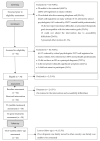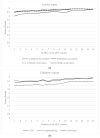The Unified Protocol for Transdiagnostic Treatment of Emotional Disorders in Children (UP-C) in Portugal: Feasibility Study Results
- PMID: 35162806
- PMCID: PMC8835210
- DOI: 10.3390/ijerph19031782
The Unified Protocol for Transdiagnostic Treatment of Emotional Disorders in Children (UP-C) in Portugal: Feasibility Study Results
Abstract
The Unified Protocol for Children (UP-C) is a transdiagnostic Cognitive-Behavioral Therapy group intervention for children and caregivers targeting the treatment of children's emotional disorders (EDs). The present study aims to assess the feasibility and acceptability of the UP-C in the Portuguese population using a single-armed design. The participants were 32 children (6-12 years of age) with an ED (anxiety and/or depressive disorder) as a main diagnosis and their parents. All participants received the UP-C intervention and were assessed at pretreatment, midtreatment, posttreatment, and 3 months posttreatment. Children, parents, the clinicians, and an external observer completed questionnaires to assess the feasibility and acceptability of the UP-C (e.g., satisfaction, motivation, and adherence). Children and parents also completed self-report measures assessing the children's anxiety and depression and its interference and severity. The results of the present study support the feasibility and acceptability of the UP-C in Portugal; low dropout rates, high adherence rates, and high levels of child and parent satisfaction and motivation were observed. Moreover, significant reductions over time in children's levels of anxiety and/or depression and of its interference and severity were found and were maintained after 3 months of follow-up. These results are promising and warrant a subsequent randomized controlled trial (RCT).
Keywords: children; emotional disorders; feasibility study; transdiagnostic intervention; unified protocol.
Conflict of interest statement
The authors declare no conflict of interest.
Figures




Similar articles
-
Study protocol for a randomized controlled trial testing the efficacy of Emotion Detectives In-Out: a blended version of the unified protocol for transdiagnostic treatment of emotional disorders in Portuguese children.BMC Psychol. 2024 Feb 7;12(1):63. doi: 10.1186/s40359-024-01532-z. BMC Psychol. 2024. PMID: 38326847 Free PMC article.
-
Feasibility study of the e-learning version of the "Journey of the Brave:" a universal anxiety-prevention program based on cognitive behavioral therapy.BMC Psychiatry. 2024 Nov 14;24(1):806. doi: 10.1186/s12888-024-06264-3. BMC Psychiatry. 2024. PMID: 39543549 Free PMC article.
-
Transdiagnostic treatment of bipolar disorder and comorbid anxiety using the Unified Protocol for Emotional Disorders: A pilot feasibility and acceptability trial.J Affect Disord. 2017 Sep;219:209-221. doi: 10.1016/j.jad.2017.05.011. Epub 2017 May 10. J Affect Disord. 2017. PMID: 28577505 Free PMC article.
-
On the efficacy of the unified protocol for transdiagnostic treatment of emotional disorders: A systematic review and meta-analysis.Clin Psychol Rev. 2021 Jul;87:101999. doi: 10.1016/j.cpr.2021.101999. Epub 2021 Mar 9. Clin Psychol Rev. 2021. PMID: 34098412
-
A systematic review and meta-analysis of the Unified Protocol as a transdiagnostic emotion regulation based intervention.Clin Psychol Rev. 2019 Aug;72:101751. doi: 10.1016/j.cpr.2019.101751. Epub 2019 Jun 25. Clin Psychol Rev. 2019. PMID: 31271848
Cited by
-
A Systematic Review Comparing Four Transdiagnostic Programmes for School-Age Children.Clin Psychol Psychother. 2025 May-Jun;32(3):e70072. doi: 10.1002/cpp.70072. Clin Psychol Psychother. 2025. PMID: 40329505 Free PMC article.
-
Effectiveness of unified protocol for trans diagnostic treatment in children with anxiety disorders: A randomized control trial.J Educ Health Promot. 2023 Nov 27;12:387. doi: 10.4103/jehp.jehp_1578_22. eCollection 2023. J Educ Health Promot. 2023. PMID: 38333174 Free PMC article.
-
The Factorial Structure, Psychometric Properties and Sensitivity to Change of the Distress Tolerance Scale for Children with Emotional Disorders.Children (Basel). 2024 Jan 17;11(1):115. doi: 10.3390/children11010115. Children (Basel). 2024. PMID: 38255428 Free PMC article.
-
Application of unified protocol as a transdiagnostic treatment for emotional disorders during COVID-19: An internet-delivered randomized controlled trial.World J Clin Cases. 2022 Aug 26;10(24):8599-8614. doi: 10.12998/wjcc.v10.i24.8599. World J Clin Cases. 2022. PMID: 36157826 Free PMC article.
-
Study protocol for a randomized controlled trial testing the efficacy of Emotion Detectives In-Out: a blended version of the unified protocol for transdiagnostic treatment of emotional disorders in Portuguese children.BMC Psychol. 2024 Feb 7;12(1):63. doi: 10.1186/s40359-024-01532-z. BMC Psychol. 2024. PMID: 38326847 Free PMC article.
References
-
- Barlow D.H., Farchione T.J., Sauer-Zavala S., Murray Latin H., Ellard K.K., Bullis J.R., Bentley K.H., Boettcher H.T., Cassiello-Robbins C. Unified Protocol for Transdiagnostic Treatment of Emotional Disorders Therapist Guide: Therapist Guide. Oxford University Press; New York, NY, USA: 2018.
-
- Bullis J.R., Boettcher H., Sauer-Zavala S., Farchione T.J., Barlow D.H. What is an emotional disorder? A transdiagnostic mechanistic definition with implications for assessment, treatment, and prevention. Clin. Psychol. 2019;26:e12278. doi: 10.1111/cpsp.12278. - DOI

